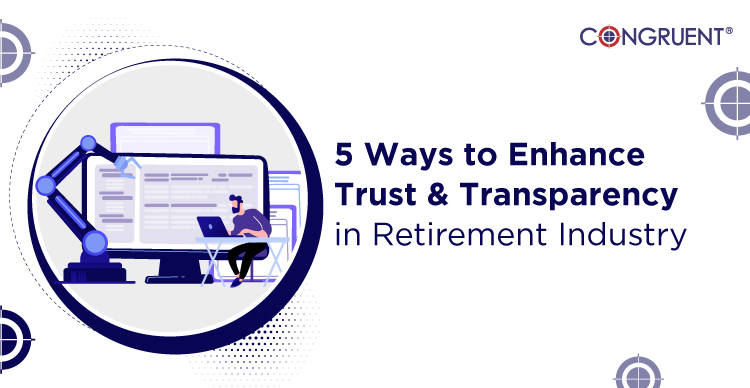
At the recently held Congruent Webinar Series on The Future of Participant Experience Innovation in the US Retirement Industry, Sagar Shankaranarayanan from Congruent Solutions put it best when he said, “People tend to trust tech companies much more than they trust their banks.”
It’s true. New age fintech apps offer customers trust and transparency, which most people seek today regarding banking, finance, and, by extension, retirement savings.
So, plan providers, it’s time to tech up. But how? What are the ways to enhance trust and transparency using technology?
1. Understand your market
Customers have evolved, attitudes have changed, and trust levels have changed. “Gen Zers are the most apprehensive. I think the young professionals, or the youngest group, are more comfortable sharing data. Millennials want advice. But once you get into the Gen Z, it’s a bit more challenging.” Claudia Step from Oculus Partners at the same webinar.
For retirement plan providers, considering the vast volumes of data being collected at every touchpoint with your participants, data analytics is an important area of focus to process customer data, including purchase history and online interactions. This will help identify customer behavior patterns, preferences, and trends across categories.
2. Personalize your approach
Personalization cannot be emphasized strongly enough. A data-driven approach can help you tailor solutions to the individual needs of your participants in much the same way that fintech solutions do. This enhances the overall customer experience in retirement planning, just as it has made financial products more relevant and valuable to consumers.
What’s more, customers want recognition and personalization in every interaction right from the get-go. “I think that that trust can be gained or lost in 2-3 minutes,” says Jason Lenardson from Lincoln Financial Group at the same webinar. “If you call your call center and they don’t know who you are and you have to start completely over again, and it’s not consistent with what they’re seeing on their phone or their application, you can lose trust quickly. For example, 360 (degree information) is a big deal now. You (as a retirement plan provider) don’t want somebody to call you about your RPS product and not know that they have an annuity or a life policy with you.”
3. Go hybrid by adding a human touch to tech
Most mid-career working professionals and young working professionals retirees seek more control and awareness in their retirement planning – especially at the consulting stage with retirement planners and advisors. A human touch is excellent in this situation, but its absence is not a dealbreaker. Tech can be leveraged to deliver a balance between control, awareness and a personal touch.
Most retirement planners have begun hybridizing using both robo and human advisors. While the former help drive decision-making through descriptive and prescriptive analytics, human advisors can help personalize the process further. Similarly, using chatbots and retirement calculators can help provide your customers with a high level of personalization, awareness, and engagement.
4. Make every interaction transparent
“We want our participants to trust the experiences that we are providing. That means easy-to-read communications, transparency in terms of plan options, and giving them the feature to share data more secured through authentication and verification that is seamless, non-intrusive,” says Ronak Doshi of Everest Group.
Technology is a great way to drive transparency – interactions with a technology platform are often inherently easier to trust simply because people trust the technology not to have its agenda. Clear communication dissemination, simplified documentation, and less paperwork are all ways technology platforms can drive transparency. And to take it further, technologies like Blockchain are purpose-built for transparency and accountability.
5. Go paperless
It’s time for the retirement industry to transition from paper documentation to electronic communications as it reduces costs and enhances tracking, trust, and transparency. Digital tools, particularly smart communications, can help promote engagement.
Just as financial applications use push notifications, for example, to nudge individuals to review their account balances, the same can be done in retirement planning to ask participants to consider increasing contributions. Incorporating technology will also automate and streamline compliance processes, data analysis, and risk management, simplifying processes and enhancing transparency and efficiency.
So, there you have it. Five areas where technology can be incorporated to help your plan participants get the most from your services. For more ways tech can help you, get in touch with Congruent.
